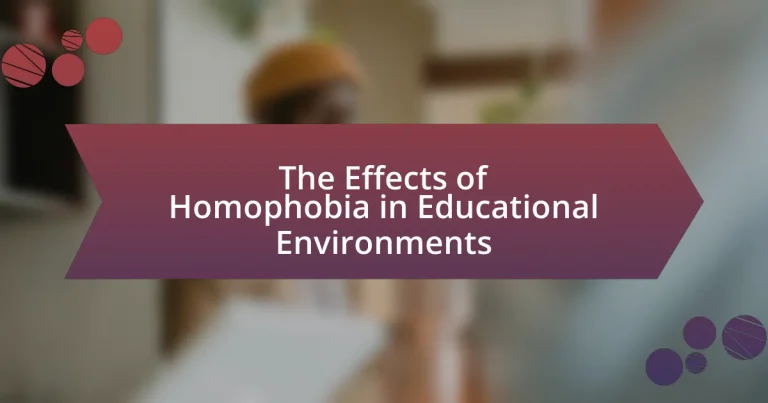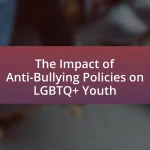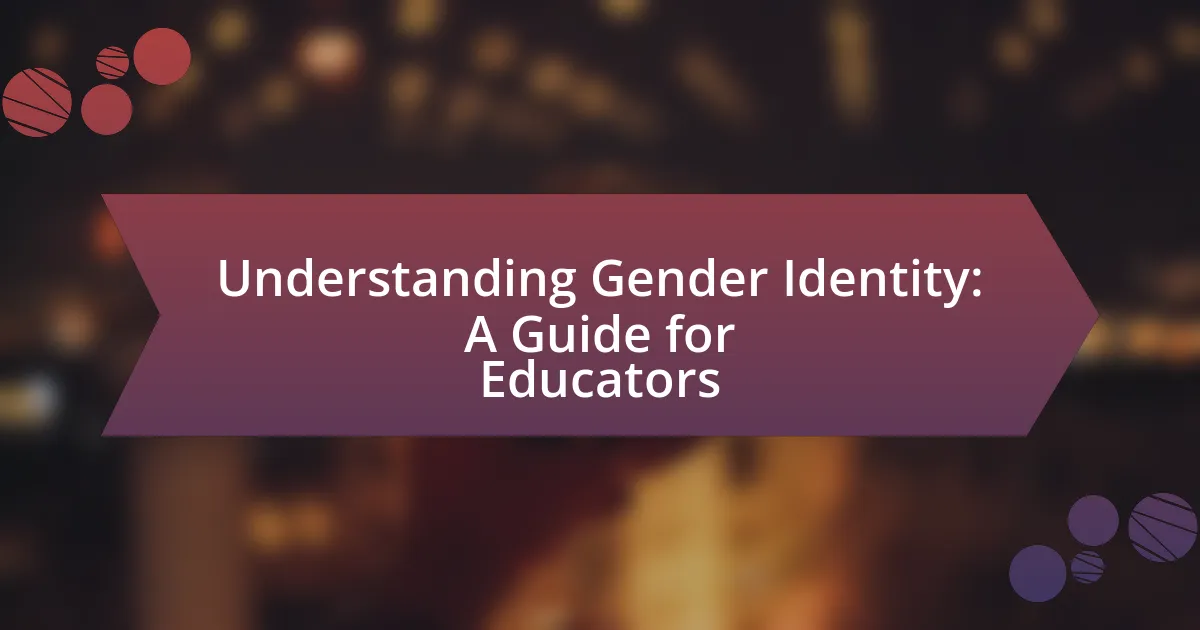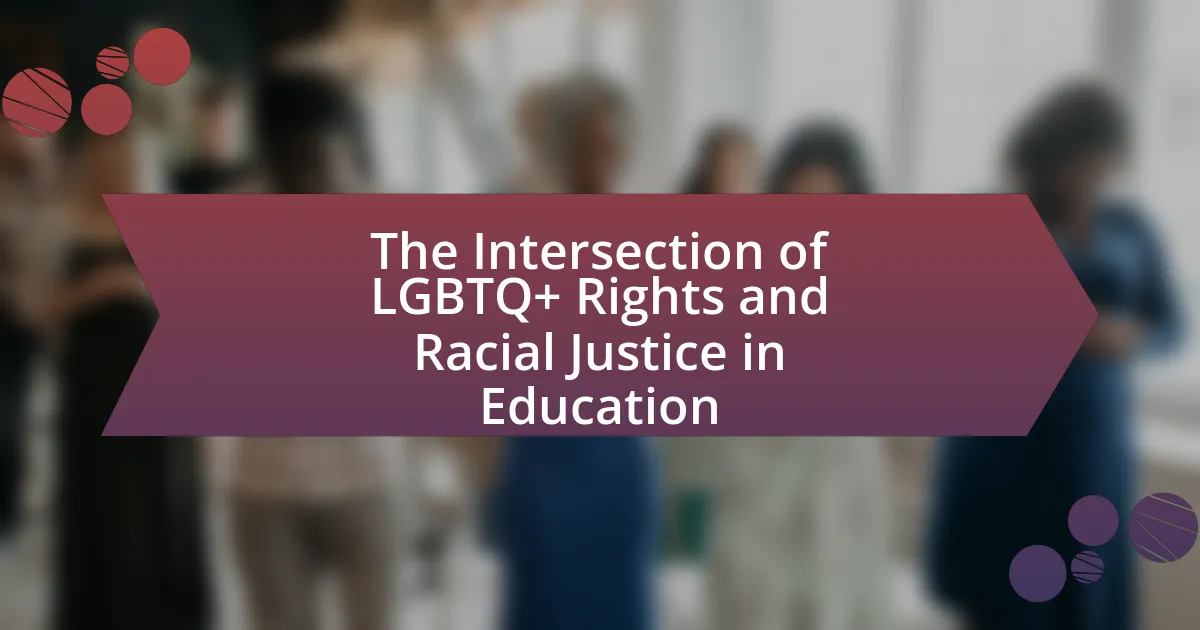The article examines the effects of homophobia in educational environments, highlighting its detrimental impact on LGBTQ+ students’ psychological well-being and academic performance. It discusses how homophobia manifests through bullying, discrimination, and exclusion, leading to increased rates of anxiety, depression, and lower self-esteem among affected students. The article also explores the role of teachers and staff in perpetuating a homophobic atmosphere, the correlation between a hostile environment and academic outcomes, and the importance of inclusive policies and peer support programs in fostering a safe and supportive educational setting. Additionally, it outlines best practices for schools to effectively support LGBTQ+ students and combat homophobia.
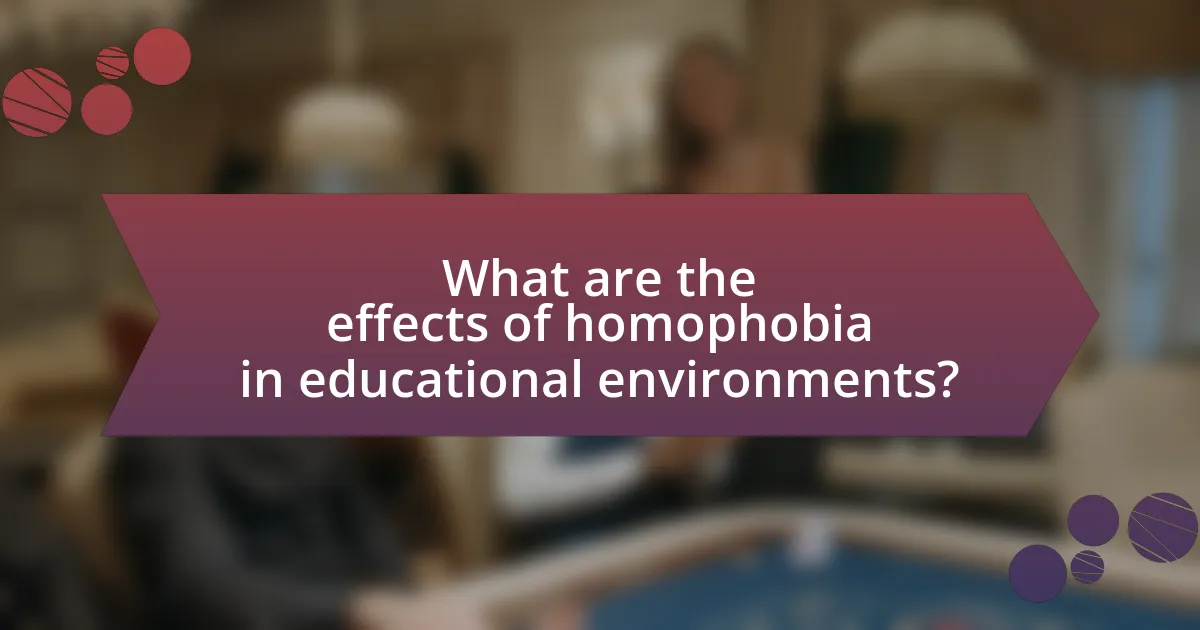
What are the effects of homophobia in educational environments?
Homophobia in educational environments leads to negative psychological and academic outcomes for LGBTQ+ students. Research indicates that students who experience homophobia are more likely to face mental health issues, such as anxiety and depression, which can hinder their academic performance. A study published in the Journal of Youth and Adolescence found that LGBTQ+ youth who reported higher levels of victimization due to their sexual orientation had lower GPAs and higher dropout rates. Additionally, homophobia creates a hostile learning environment, reducing overall school safety and inclusivity, which further impacts students’ ability to engage and succeed in their education.
How does homophobia manifest in schools?
Homophobia manifests in schools through bullying, discrimination, and exclusion of LGBTQ+ students. Research indicates that LGBTQ+ students often face verbal harassment, physical violence, and social ostracism from peers, which can lead to severe emotional distress and academic challenges. A study by the Gay, Lesbian & Straight Education Network (GLSEN) found that 59.1% of LGBTQ+ students felt unsafe at school due to their sexual orientation, highlighting the pervasive nature of this issue. Additionally, teachers may inadvertently contribute to a hostile environment by failing to address homophobic remarks or by not including LGBTQ+ topics in the curriculum, further marginalizing these students.
What behaviors indicate the presence of homophobia among students?
Behaviors indicating the presence of homophobia among students include derogatory language, bullying, exclusion of peers based on sexual orientation, and the expression of negative stereotypes about LGBTQ+ individuals. Research shows that students who use slurs or engage in name-calling create a hostile environment, which can lead to increased anxiety and decreased academic performance among targeted individuals. Additionally, studies indicate that students who witness or participate in bullying related to sexual orientation are more likely to internalize homophobic attitudes, perpetuating a cycle of discrimination.
How do teachers and staff contribute to a homophobic environment?
Teachers and staff contribute to a homophobic environment by perpetuating discriminatory attitudes and behaviors, which can manifest through biased language, lack of inclusive policies, and failure to address bullying. For instance, when educators use derogatory terms or dismiss LGBTQ+ topics in the curriculum, they reinforce negative stereotypes and create an unsafe atmosphere for students. Research indicates that schools with supportive staff and inclusive policies report lower instances of bullying and higher student well-being, highlighting the critical role that teachers and staff play in shaping a respectful and accepting educational environment.
What impact does homophobia have on student mental health?
Homophobia significantly negatively impacts student mental health, leading to increased rates of anxiety, depression, and suicidal ideation. Research indicates that LGBTQ+ students who experience homophobic bullying are more likely to report mental health issues; for instance, a study published in the Journal of Adolescent Health found that 42% of LGBTQ+ youth reported seriously considering suicide compared to 14% of their heterosexual peers. Additionally, the stress from experiencing or witnessing homophobia can contribute to a hostile school environment, further exacerbating mental health challenges.
How does experiencing homophobia affect students’ self-esteem?
Experiencing homophobia significantly lowers students’ self-esteem. Research indicates that students who face homophobic bullying or discrimination often report feelings of worthlessness and social isolation. A study published in the Journal of Youth and Adolescence found that LGBTQ+ students who experienced victimization had lower self-esteem levels compared to their peers, with 60% of those affected reporting negative impacts on their mental health. This correlation highlights how homophobia directly undermines students’ confidence and sense of belonging in educational settings.
What are the long-term psychological effects of homophobia on students?
Long-term psychological effects of homophobia on students include increased rates of anxiety, depression, and low self-esteem. Research indicates that students who experience homophobic bullying are more likely to develop mental health issues, with a study by the Gay, Lesbian & Straight Education Network (GLSEN) revealing that 60% of LGBTQ+ students felt unsafe at school due to their sexual orientation. This persistent fear and marginalization can lead to chronic stress, impacting academic performance and social relationships. Furthermore, students internalizing homophobic attitudes may struggle with identity acceptance, resulting in long-lasting emotional distress and isolation.
How does homophobia influence academic performance?
Homophobia negatively influences academic performance by creating a hostile environment that affects students’ mental health and engagement. Research indicates that students who experience or perceive homophobia often face increased anxiety, depression, and lower self-esteem, which can lead to decreased academic motivation and performance. A study published in the Journal of Educational Psychology found that LGBTQ+ students who reported high levels of victimization due to homophobia had significantly lower GPAs compared to their peers. This correlation highlights how a lack of acceptance and support in educational settings can hinder academic success.
What correlation exists between a homophobic environment and student grades?
A homophobic environment negatively correlates with student grades, as students in such settings often experience increased stress and anxiety, which can hinder academic performance. Research indicates that students who perceive their school environment as hostile towards LGBTQ+ individuals tend to have lower academic achievement and higher dropout rates. For instance, a study published in the Journal of Educational Psychology found that students in supportive environments had significantly higher GPAs compared to those in homophobic settings, highlighting the detrimental impact of discrimination on educational outcomes.
How does fear of bullying affect students’ participation in class?
Fear of bullying significantly reduces students’ participation in class. When students are anxious about being bullied, they are less likely to engage in discussions, ask questions, or contribute to group activities. Research indicates that students who experience or fear bullying often report lower self-esteem and increased anxiety, which directly correlates with their willingness to participate in academic settings. For instance, a study published in the Journal of Educational Psychology found that students who felt unsafe in their learning environment were 30% less likely to participate in class discussions compared to their peers in supportive environments. This fear not only hinders their academic performance but also affects their social development and overall school experience.
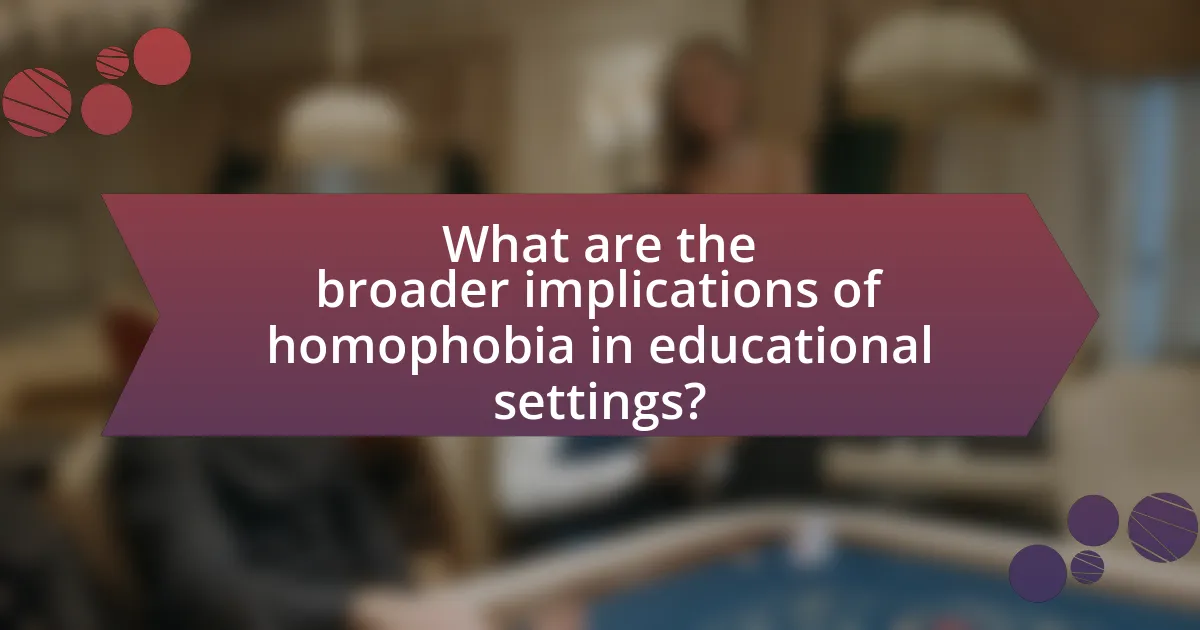
What are the broader implications of homophobia in educational settings?
Homophobia in educational settings leads to significant negative implications, including increased mental health issues among LGBTQ+ students and a hostile learning environment. Research indicates that students who experience homophobia are more likely to suffer from anxiety, depression, and lower academic performance. A study published in the Journal of School Psychology found that LGBTQ+ youth who face bullying and discrimination are at a higher risk for suicidal ideation and self-harm. Furthermore, homophobia can perpetuate a culture of intolerance, affecting not only the targeted individuals but also the overall school climate, leading to decreased safety and inclusivity for all students. This creates barriers to learning and personal development, ultimately hindering the educational experience for the entire student body.
How does homophobia affect school culture and climate?
Homophobia negatively impacts school culture and climate by fostering an environment of fear, exclusion, and hostility among students and staff. This detrimental atmosphere can lead to decreased academic performance, increased absenteeism, and higher dropout rates among LGBTQ+ students, as evidenced by a study conducted by the Gay, Lesbian and Straight Education Network (GLSEN) in 2019, which found that 59% of LGBTQ+ students felt unsafe at school due to their sexual orientation. Furthermore, homophobia can perpetuate bullying and harassment, contributing to a toxic school environment that affects all students, not just those who identify as LGBTQ+. The overall school climate becomes less inclusive and supportive, hindering the development of a positive educational experience for everyone involved.
What role do peer relationships play in perpetuating homophobia?
Peer relationships significantly contribute to the perpetuation of homophobia by reinforcing negative attitudes and behaviors towards LGBTQ+ individuals. In educational environments, students often seek acceptance and validation from their peers, leading them to adopt homophobic language and actions to fit in with social norms. Research indicates that peer influence is a critical factor in shaping attitudes; for instance, a study published in the Journal of Youth and Adolescence found that adolescents are more likely to express homophobic sentiments when they perceive such attitudes as socially acceptable within their peer groups. This dynamic creates an environment where homophobia is normalized, discouraging open discussions about sexual orientation and fostering a culture of silence and discrimination.
How can a homophobic environment hinder inclusivity and diversity?
A homophobic environment hinders inclusivity and diversity by creating a culture of fear and exclusion for LGBTQ+ individuals. This environment discourages open expression of identity, leading to decreased participation and engagement from those who feel unsafe or unwelcome. Research indicates that schools with high levels of homophobia experience lower academic performance and higher dropout rates among LGBTQ+ students, as they often face bullying and discrimination. For instance, a study by the Gay, Lesbian and Straight Education Network (GLSEN) found that 59.1% of LGBTQ+ students felt unsafe at school due to their sexual orientation, which directly impacts their ability to thrive in an educational setting. Thus, a homophobic atmosphere not only marginalizes individuals but also undermines the overall diversity and inclusivity of the educational community.
What legal and policy frameworks address homophobia in education?
Legal and policy frameworks addressing homophobia in education include anti-discrimination laws, educational policies promoting inclusivity, and specific guidelines from educational authorities. For instance, in the United States, Title IX of the Education Amendments of 1972 prohibits sex-based discrimination in federally funded education programs, which has been interpreted to include protections against discrimination based on sexual orientation and gender identity. Additionally, many states have enacted laws that require schools to implement anti-bullying policies that specifically address harassment based on sexual orientation. The Safe Schools Improvement Act, proposed at the federal level, aims to ensure that schools adopt comprehensive anti-bullying policies that include protections for LGBTQ+ students. These frameworks collectively aim to create safer educational environments by legally mandating the protection of students from homophobic discrimination and harassment.
What protections exist for LGBTQ+ students in schools?
LGBTQ+ students in schools are protected by various federal and state laws that prohibit discrimination based on sexual orientation and gender identity. Title IX of the Education Amendments of 1972 is a key federal law that prohibits sex-based discrimination in federally funded education programs, which has been interpreted to include protections for LGBTQ+ students. Additionally, many states have enacted specific anti-bullying laws that include protections for LGBTQ+ individuals, ensuring that schools must address harassment and discrimination based on sexual orientation or gender identity. For instance, the Human Rights Campaign reports that as of 2021, 22 states and the District of Columbia have laws explicitly protecting LGBTQ+ students from discrimination in schools.
How effective are anti-bullying policies in combating homophobia?
Anti-bullying policies are effective in combating homophobia, as they create a safer and more inclusive environment for LGBTQ+ students. Research indicates that schools with comprehensive anti-bullying policies report lower instances of homophobic bullying and increased support for LGBTQ+ students. For example, a study published in the Journal of School Psychology found that schools implementing such policies saw a 20% reduction in reported bullying incidents, including those based on sexual orientation. Additionally, these policies often include training for staff and students, which fosters awareness and understanding, further mitigating homophobic behavior.
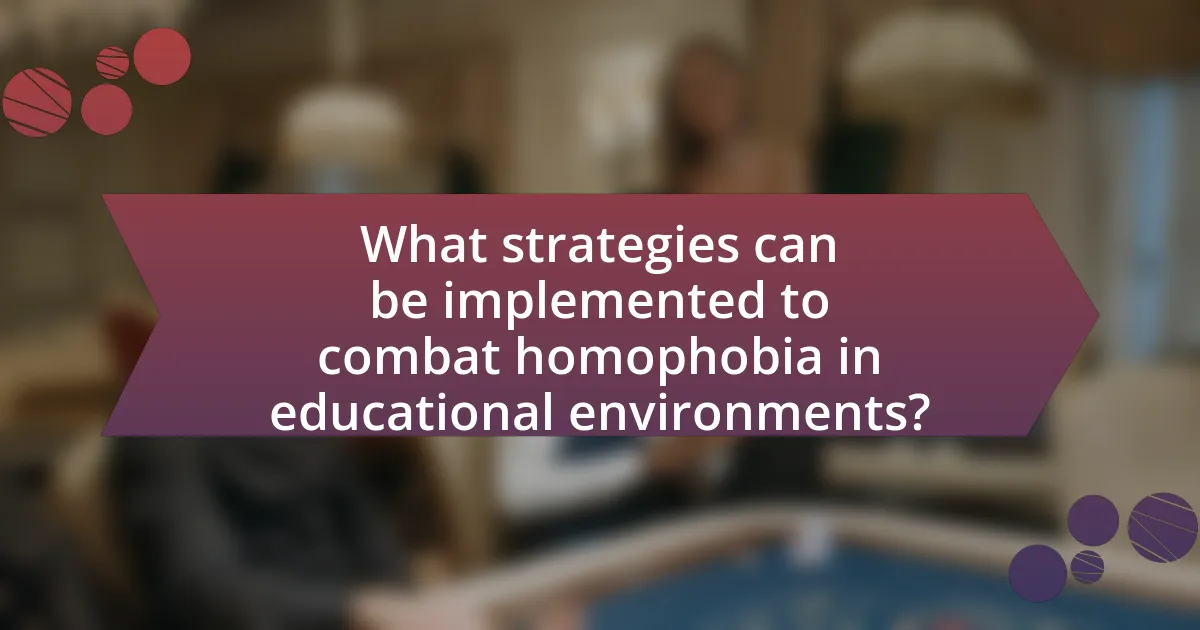
What strategies can be implemented to combat homophobia in educational environments?
To combat homophobia in educational environments, implementing comprehensive anti-bullying policies is essential. These policies should explicitly include protections based on sexual orientation and gender identity, creating a safe space for all students. Research indicates that schools with clear anti-bullying policies see a significant reduction in incidents of harassment; for instance, a study by the Gay, Lesbian & Straight Education Network (GLSEN) found that schools with such policies reported lower levels of victimization among LGBTQ+ students. Additionally, incorporating LGBTQ+ inclusive curricula can foster understanding and acceptance, as evidenced by findings from the University of California, which show that inclusive education leads to more positive attitudes among students towards their LGBTQ+ peers. Training staff on LGBTQ+ issues and cultural competency further equips educators to address homophobia effectively, creating a supportive environment for all students.
How can educators create a more inclusive classroom environment?
Educators can create a more inclusive classroom environment by implementing diverse teaching strategies that acknowledge and respect all students’ identities. This includes integrating LGBTQ+ topics into the curriculum, which has been shown to foster a sense of belonging and reduce feelings of isolation among LGBTQ+ students. Research from GLSEN indicates that schools with inclusive curricula report lower levels of harassment and bullying, demonstrating the positive impact of representation on student well-being. Additionally, educators should establish clear anti-bullying policies and promote open discussions about diversity, which can further enhance inclusivity and support for all students.
What training can teachers undergo to better address homophobia?
Teachers can undergo training programs focused on LGBTQ+ inclusivity and anti-bullying strategies to better address homophobia. These programs often include workshops on understanding sexual orientation and gender identity, developing empathy, and creating safe classroom environments. Research indicates that comprehensive training can significantly reduce incidents of homophobic bullying and improve the overall school climate. For instance, a study by GLSEN (Gay, Lesbian & Straight Education Network) found that schools with trained staff reported lower levels of harassment based on sexual orientation.
How can curriculum changes promote understanding and acceptance?
Curriculum changes can promote understanding and acceptance by integrating diverse perspectives and inclusive content that reflects various identities and experiences. For instance, incorporating LGBTQ+ history and literature into the curriculum fosters empathy and awareness among students, which has been shown to reduce prejudice and discrimination. Research from GLSEN indicates that schools with inclusive curricula report lower levels of homophobic bullying and higher levels of acceptance among peers. By actively engaging students with materials that challenge stereotypes and promote dialogue, educational institutions can create a more inclusive environment that values diversity and encourages mutual respect.
What role do students play in reducing homophobia in schools?
Students play a crucial role in reducing homophobia in schools by fostering an inclusive environment and challenging discriminatory behaviors. By actively participating in awareness campaigns, students can educate their peers about LGBTQ+ issues, which has been shown to decrease instances of bullying and harassment. Research indicates that schools with student-led initiatives, such as Gay-Straight Alliances, report lower levels of homophobic behavior and increased acceptance among students. Furthermore, when students speak out against homophobic remarks or actions, they contribute to a culture of respect and support, which is essential for creating a safe educational environment.
How can student-led initiatives foster a culture of acceptance?
Student-led initiatives can foster a culture of acceptance by actively promoting inclusivity and understanding among peers. These initiatives, such as diversity clubs or awareness campaigns, create safe spaces for dialogue and education about different identities, which helps to reduce stigma and prejudice. Research indicates that peer-led programs significantly enhance empathy and acceptance, as students often relate better to their peers than to adults. For example, a study published in the Journal of School Psychology found that schools implementing student-led anti-bullying programs saw a 30% decrease in incidents of homophobic bullying, demonstrating the effectiveness of student involvement in fostering acceptance.
What peer support programs can help LGBTQ+ students feel safe?
Peer support programs such as Gay-Straight Alliances (GSAs) and LGBTQ+ mentorship initiatives can significantly help LGBTQ+ students feel safe. GSAs provide a supportive environment where students can connect, share experiences, and advocate for inclusivity within their schools. Research indicates that schools with GSAs report lower levels of bullying and harassment, contributing to a safer atmosphere for LGBTQ+ students. Additionally, mentorship programs that pair LGBTQ+ youth with supportive adults or peers can foster resilience and provide guidance, further enhancing feelings of safety and belonging. These programs are essential in combating the negative effects of homophobia in educational settings.
What are some best practices for schools to support LGBTQ+ students?
Schools can support LGBTQ+ students by implementing inclusive policies, providing training for staff, and creating safe spaces. Inclusive policies should include anti-discrimination measures that explicitly protect LGBTQ+ students, which research shows can significantly reduce bullying and improve mental health outcomes. Staff training on LGBTQ+ issues fosters understanding and equips educators to address the unique challenges these students face. Additionally, establishing safe spaces, such as LGBTQ+ clubs or support groups, encourages community and belonging, which studies indicate can enhance academic performance and emotional well-being among LGBTQ+ youth.
